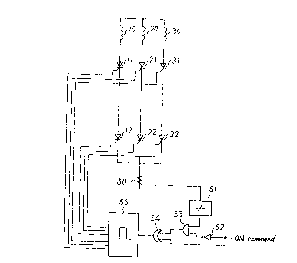Some of the information on this Web page has been provided by external sources. The Government of Canada is not responsible for the accuracy, reliability or currency of the information supplied by external sources. Users wishing to rely upon this information should consult directly with the source of the information. Content provided by external sources is not subject to official languages, privacy and accessibility requirements.
Any discrepancies in the text and image of the Claims and Abstract are due to differing posting times. Text of the Claims and Abstract are posted:
| (12) Patent: | (11) CA 2072296 |
|---|---|
| (54) English Title: | SWITCHING CIRUCIT PROTECTION APPARATUS AND METHOD |
| (54) French Title: | APPAREIL DE PROTECTION DE CIRCUIT DE COMMUTATION ET METHODE CONNEXE |
| Status: | Expired and beyond the Period of Reversal |
| (51) International Patent Classification (IPC): |
|
|---|---|
| (72) Inventors : |
|
| (73) Owners : |
|
| (71) Applicants : |
|
| (74) Agent: | NORTON ROSE FULBRIGHT CANADA LLP/S.E.N.C.R.L., S.R.L. |
| (74) Associate agent: | |
| (45) Issued: | 1997-10-28 |
| (22) Filed Date: | 1992-06-25 |
| (41) Open to Public Inspection: | 1992-12-27 |
| Examination requested: | 1992-06-25 |
| Availability of licence: | N/A |
| Dedicated to the Public: | N/A |
| (25) Language of filing: | English |
| Patent Cooperation Treaty (PCT): | No |
|---|
| (30) Application Priority Data: | ||||||
|---|---|---|---|---|---|---|
|
In a switching circuit having multiple parallel
circuits having at least one switching element having a
characteristic of firing by themselves due to over-voltage,
this invention is to provide a switching circuit protection
apparatus which prevents the flowing of a current
concentrated in the first of the parallel circuits to fire
due to over-voltage.
The apparatus in this invention comprises a switching
circuit composed by connecting in parallel multiple circuits
having at least one switching element having a
characteristic of self-firing due to over-voltage, detecting
means for detecting the self-firing of the switching element
in the switching circuit, and firing means for applying an
firing pulse to all the switching elements in response to an
output signal applied from the detecting means and firing
all the switching elements at the same time by the firing
pulse.
Dans un circuit de commutation comportant plusieurs circuits parallèles, dotés d'au moins un élément de commutation et ayant la particularité de s'autoenclencher en condition de surtension, la présente invention consiste en un appareil de protection de circuit de commutation ayant pour effet d'empêcher que le passage d'un courant concentré dans le premier circuit parallèle ne provoque l'enchenchement de ce circuit en cas de surtension. L'appareil visé par l'invention comprend un circuit de commutation qui intègre plusieurs circuits parallèles dotés d'au moins un élément de commutation et ayant la particularité de s'autoenclencher en condition de surtension, un dispositif qui détecte l'autoenclenchement de l'élément de commutation ainsi qu'un dispositif d'enclenchement qui fonctionne au moyen d'une impulsion envoyée à tous les éléments de commutation lorsque le dispositif de détection émet un signal de sortie. L'impulsion provoque l'enclenchement simultané de tous les éléments de commutation.
Note: Claims are shown in the official language in which they were submitted.
Note: Descriptions are shown in the official language in which they were submitted.

2024-08-01:As part of the Next Generation Patents (NGP) transition, the Canadian Patents Database (CPD) now contains a more detailed Event History, which replicates the Event Log of our new back-office solution.
Please note that "Inactive:" events refers to events no longer in use in our new back-office solution.
For a clearer understanding of the status of the application/patent presented on this page, the site Disclaimer , as well as the definitions for Patent , Event History , Maintenance Fee and Payment History should be consulted.
| Description | Date |
|---|---|
| Inactive: IPC from MCD | 2006-03-11 |
| Inactive: IPC from MCD | 2006-03-11 |
| Inactive: IPC from MCD | 2006-03-11 |
| Time Limit for Reversal Expired | 2003-06-25 |
| Letter Sent | 2002-06-25 |
| Letter Sent | 1999-12-06 |
| Grant by Issuance | 1997-10-28 |
| Inactive: Application prosecuted on TS as of Log entry date | 1997-08-22 |
| Inactive: Status info is complete as of Log entry date | 1997-08-22 |
| Pre-grant | 1997-07-16 |
| Notice of Allowance is Issued | 1997-01-28 |
| Application Published (Open to Public Inspection) | 1992-12-27 |
| All Requirements for Examination Determined Compliant | 1992-06-25 |
| Request for Examination Requirements Determined Compliant | 1992-06-25 |
There is no abandonment history.
| Fee Type | Anniversary Year | Due Date | Paid Date |
|---|---|---|---|
| Final fee - standard | 1997-07-16 | ||
| MF (patent, 6th anniv.) - standard | 1998-06-25 | 1998-05-04 | |
| MF (patent, 7th anniv.) - standard | 1999-06-25 | 1999-05-03 | |
| MF (patent, 8th anniv.) - standard | 2000-06-26 | 1999-05-18 | |
| MF (patent, 9th anniv.) - standard | 2001-06-25 | 2001-05-16 |
Note: Records showing the ownership history in alphabetical order.
| Current Owners on Record |
|---|
| KABUSHIKI KAISHA TOSHIBA |
| Past Owners on Record |
|---|
| TAKEO KANAI |